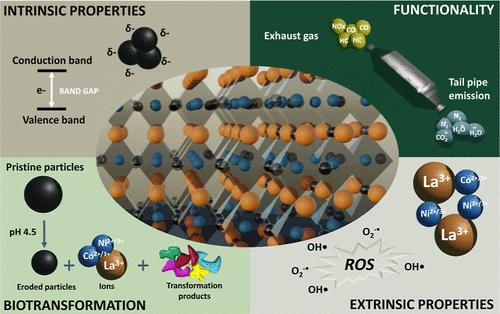Our official English website, www.x-mol.net, welcomes your
feedback! (Note: you will need to create a separate account there.)
Oxide-Perovskites for Automotive Catalysts Biotransform and Induce Multicomponent Clearance and Hazard
ACS Nano ( IF 15.8 ) Pub Date : 2024-11-13 , DOI: 10.1021/acsnano.4c10135 Veronica Di Battista, Pernille Høgh Danielsen, Agnieszka Gajewicz-Skretna, Andrzej Kedziorski, Svenja B. Seiffert, Lan Ma-Hock, Trine Berthing, Alicja Mortensen, Andreas Sundermann, Lars Michael Skjolding, Ulla Vogel, Anders Baun, Wendel Wohlleben
ACS Nano ( IF 15.8 ) Pub Date : 2024-11-13 , DOI: 10.1021/acsnano.4c10135 Veronica Di Battista, Pernille Høgh Danielsen, Agnieszka Gajewicz-Skretna, Andrzej Kedziorski, Svenja B. Seiffert, Lan Ma-Hock, Trine Berthing, Alicja Mortensen, Andreas Sundermann, Lars Michael Skjolding, Ulla Vogel, Anders Baun, Wendel Wohlleben

|
Oxide-perovskites designed for automotive catalysts contain multiple metal elements whose presence is crucial to achieving the targeted performance. They are highly stable in exhaust operating conditions; however, little is known about their stability under physiological conditions. As some of the metallic components are hazardous to humans and the environment, perovskite benefits in cleaner air must be balanced with risks in a Safe and Sustainable Design (SSbD) approach. New approach methodologies (NAMs), including in chemico and in silico methods, were used for testing hazards and benefits, including catalytic activity and tolerance for temporary excess of oxygen under dynamic driving conditions. The composition and surface properties of six different lanthanum-based oxide-perovskites compromised their stability under lung physiological conditions, influencing the oxidative damage of the particles and the bioacessibility of leaching metals. We found consistent biotransformation of the oxide-perovskite materials at pH 4.5. The leached lanthanum ions, but not other metals, respeciated into lanthanum phosphate nanoparticles, which increased the overall oxidative damage in additive synergy. The NAM results in the presented SSbD approach were challenged by in vivo studies in rats and mice, which confirmed multicomponent clearance from lungs into urine and supported the comparative ranking of effects against well-characterized spinel materials. Among the perovskites, the version with reduced nickel content and doped with palladium offered the best SSbD balance, despite not improving the conventional benchmark catalytic performance and related sustainability benefits. Redesign by industry may be necessary to better fulfill all SSbD dimensions.
中文翻译:

用于汽车催化剂的氧化物钙钛矿生物转化并诱导多组分清除和危险
专为汽车催化剂设计的氧化物钙钛矿包含多种金属元素,这些元素的存在对于实现目标性能至关重要。它们在排气操作条件下高度稳定;然而,人们对它们在生理条件下的稳定性知之甚少。由于一些金属成分对人类和环境有害,因此钙钛矿在更清洁空气中的好处必须与安全和可持续设计 (SSbD) 方法中的风险相平衡。新方法方法 (NAM),包括化学和计算机方法,用于测试危害和益处,包括催化活性和动态驾驶条件下对暂时过量氧气的耐受性。六种不同的镧基氧化物钙钛矿的组成和表面性质损害了它们在肺生理条件下的稳定性,影响了颗粒的氧化损伤和浸出金属的生物利用性。我们发现氧化物钙钛矿材料在 pH 值为 4.5 时具有一致的生物转化。浸出的镧离子(而不是其他金属)重新分化成磷酸镧纳米颗粒,这增加了添加剂协同作用中的整体氧化损伤。所提出的 SSbD 方法中的 NAM 结果受到大鼠和小鼠体内研究的挑战,该研究证实了从肺部到尿液的多组分清除,并支持对表征良好的尖晶石材料的影响比较排名。在钙钛矿中,镍含量较低且掺杂钯的版本提供了最佳的 SSbD 平衡,尽管没有改善传统的基准催化性能和相关的可持续性优势。为了更好地满足所有 SSbD 维度,可能需要由行业重新设计。
更新日期:2024-11-14
中文翻译:

用于汽车催化剂的氧化物钙钛矿生物转化并诱导多组分清除和危险
专为汽车催化剂设计的氧化物钙钛矿包含多种金属元素,这些元素的存在对于实现目标性能至关重要。它们在排气操作条件下高度稳定;然而,人们对它们在生理条件下的稳定性知之甚少。由于一些金属成分对人类和环境有害,因此钙钛矿在更清洁空气中的好处必须与安全和可持续设计 (SSbD) 方法中的风险相平衡。新方法方法 (NAM),包括化学和计算机方法,用于测试危害和益处,包括催化活性和动态驾驶条件下对暂时过量氧气的耐受性。六种不同的镧基氧化物钙钛矿的组成和表面性质损害了它们在肺生理条件下的稳定性,影响了颗粒的氧化损伤和浸出金属的生物利用性。我们发现氧化物钙钛矿材料在 pH 值为 4.5 时具有一致的生物转化。浸出的镧离子(而不是其他金属)重新分化成磷酸镧纳米颗粒,这增加了添加剂协同作用中的整体氧化损伤。所提出的 SSbD 方法中的 NAM 结果受到大鼠和小鼠体内研究的挑战,该研究证实了从肺部到尿液的多组分清除,并支持对表征良好的尖晶石材料的影响比较排名。在钙钛矿中,镍含量较低且掺杂钯的版本提供了最佳的 SSbD 平衡,尽管没有改善传统的基准催化性能和相关的可持续性优势。为了更好地满足所有 SSbD 维度,可能需要由行业重新设计。


















































 京公网安备 11010802027423号
京公网安备 11010802027423号